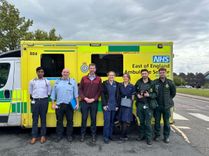Stroke patients receive fast-track care thanks to video assessment
Date: 17 May 2024May is Stroke Action Month and East of England Ambulance Service NHS Trust (EEAST) is sharing details of how it's helped over 700 people around the region get the right assessment and care faster.

In the year 2022/23 alone, a total of 91,162 patients in the UK were admitted to hospital with a stroke. Getting the right help quickly makes a huge difference to how stroke patients recover – so every second counts.
EEAST has set up partnerships with nine hospitals around the region, piloting video assessment programmes that provide swifter access to life-saving treatment.
The system allows ambulance crews to assess suspected stroke patients by linking with a hospital stroke specialist via a tablet.
Brittany Wells, clinical lead for stroke video triage at EEAST, said:
“The faster we can give patients the correct diagnosis, the faster they can have the correct treatment and the better their likely outcome.
"Video assessment enables stroke specialists to see patients remotely, before they arrive at hospital. The best thing is we can achieve this using technology already available to us.”
The joint assessment allows stroke patients to go straight to specialist hospital care without the need for assessment in the emergency department (A&E).
Stroke specialists can also request imaging and tests before the patient’s arrival, providing prompt imaging, earlier treatment and improved patient outcomes.
Stroke patients can also receive hyper-acute stroke care sooner. This is the intensive care a patient receives in a stroke ward for the first 72 hours post-stroke.
Dr Tolu Adesina, consultant stroke physician and clinical lead for stroke at West Herts Teaching Hospitals NHS Trust (WHTH), said:
“This is helping patients to be taken directly for urgent scans, increasing the speed they receive stroke intervention treatment and reducing handover times from the paramedic staff.
“We have found this an extremely useful innovation, with one patient being scanned within two minutes of arrival.”
The programme has been recently rolled-out at the Norfolk and Norwich University Hospital.
Kneale Metcalf, consultant stroke physician at NNUH, said:
“This is providing patients with access to high level stroke care, wherever they are, ensuring they are then given the appropriate treatment and investigations as quickly as possible.
“We’re able to pre-alert our Computerised Tomography (CT) scanner so patients can be sent straight for a scan and onto the relevant ward.
“It is therefore also reducing unnecessary transfers to the Emergency Department and the burden on the ambulance service. Bypassing the Emergency Department appropriately is better for everyone. It is better for the wait times in the Emergency Department and the volume of emergency patients that need to be seen.”
EEAST has been running the programme since 2022. Around 60% of the assessed patients are pre-booked into specialist stroke care for a scan or further assessment.
One patient that experienced the video triaging system said:
“Excellent use of technology to provide a quick and efficient assessment by a specialist in advance of being taken to hospital.
“I was reassured and well looked after by the ambulance crew who also worked well with the video consultant.”
Another said:
“I was impressed that the assessment took place in the ambulance before we left my place of work. This meant that the most appropriate hospital could be chosen for my condition and we went directly to the best place.”
| Hospital and programme inception date | Patients helped (to March 2024) |
|---|---|
| Peterborough (Oct 2022) | 182 |
| West Essex (Oct 2022) | 418 |
| QEHKL (Nov 2023) | 17 |
| Lister (Dec 2023) | 30 |
| Watford (Dec 2023) | 48 |
| Mid & South Essex (three sites) (Jan 2024) | 26 |
| NNUH (Feb 2024) | 2 |
| Totals | 723 |
Further information:
